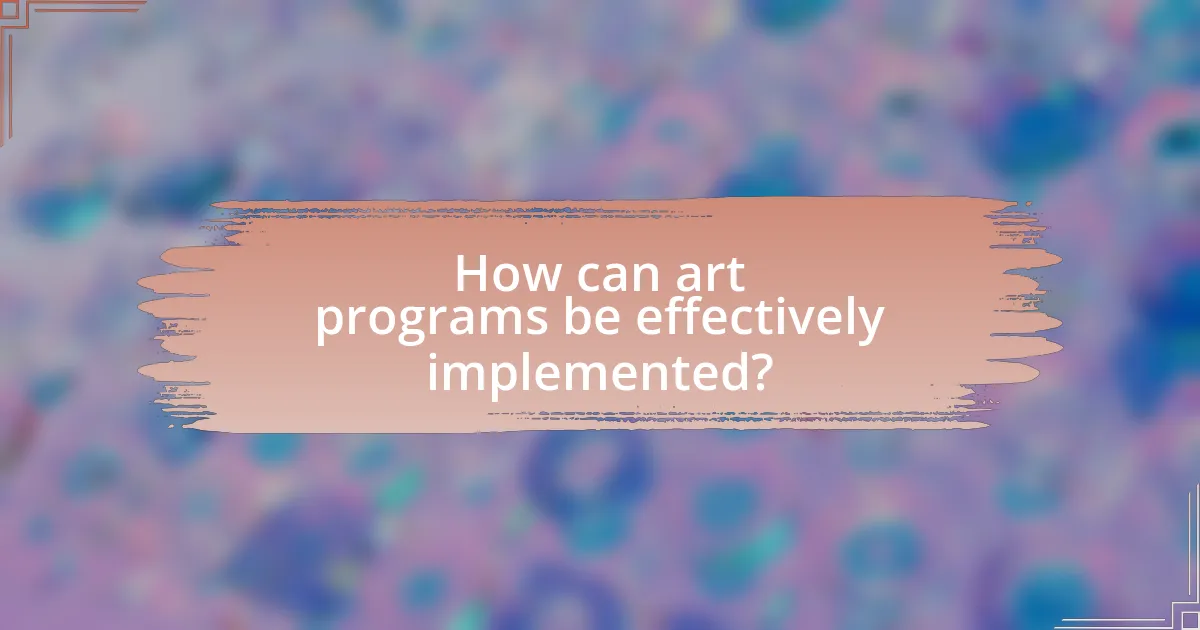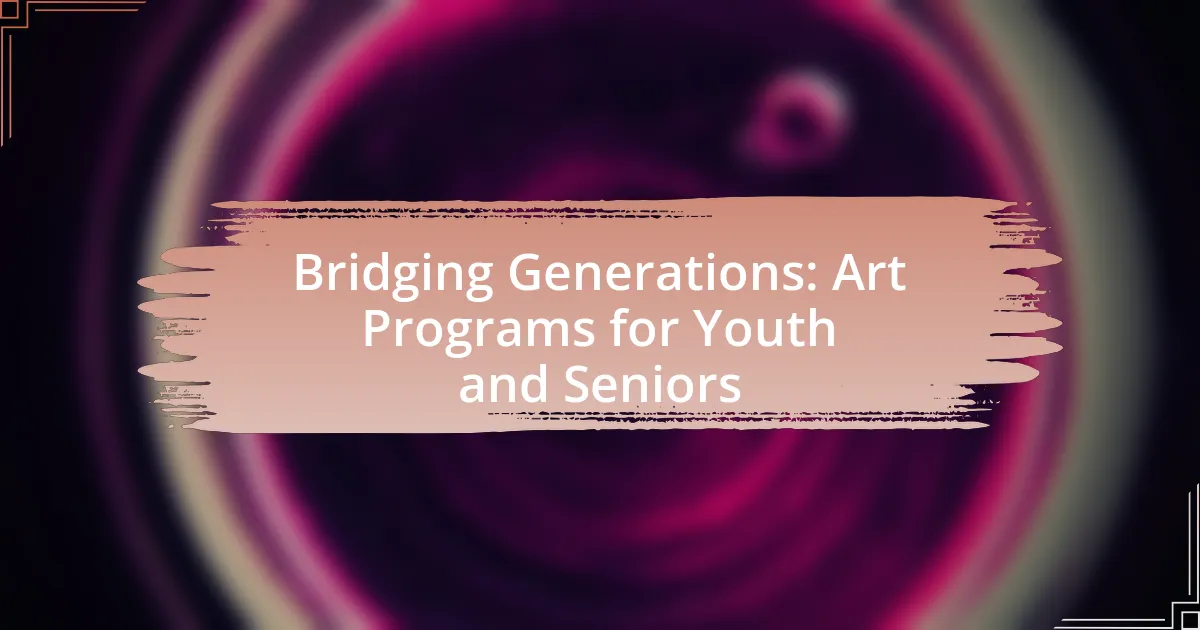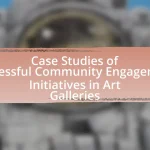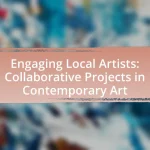Art programs for youth and seniors are structured activities that promote creative expression through various artistic mediums, such as painting, drawing, and sculpture. These programs facilitate intergenerational connections, enhance cognitive and emotional well-being, and improve social skills among participants. Research indicates that involvement in art initiatives can reduce feelings of isolation in seniors while providing youth with mentorship opportunities and critical thinking development. The article explores the types of activities included in these programs, their psychological benefits, challenges faced, and successful examples, emphasizing the importance of community involvement and accessibility in fostering meaningful engagement across generations.

What are Art Programs for Youth and Seniors?
Art programs for youth and seniors are structured activities designed to engage these age groups in creative expression through various artistic mediums. These programs often include painting, drawing, sculpture, and crafts, fostering intergenerational connections and enhancing cognitive and emotional well-being. Research indicates that participation in art programs can improve mental health and social skills, with studies showing that seniors involved in creative activities experience reduced feelings of isolation and increased life satisfaction. Additionally, youth benefit from mentorship opportunities and the development of critical thinking skills through collaborative projects with seniors.
How do these programs facilitate intergenerational connections?
Art programs for youth and seniors facilitate intergenerational connections by creating collaborative environments where participants engage in shared creative activities. These programs encourage communication and relationship-building through joint projects, such as painting or crafting, which require teamwork and dialogue. Research indicates that such interactions can enhance social skills and reduce feelings of isolation among seniors while fostering empathy and understanding in youth. For example, a study published in the Journal of Intergenerational Relationships found that participants in intergenerational art programs reported increased feelings of connection and mutual respect, demonstrating the effectiveness of these initiatives in bridging generational gaps.
What types of art activities are included in these programs?
The art programs for youth and seniors include a variety of activities such as painting, drawing, sculpture, and mixed media projects. These activities are designed to foster creativity and encourage collaboration between different age groups. Research indicates that engaging in these types of art activities can enhance cognitive function and emotional well-being, particularly in older adults, while also promoting social interaction and skill development among youth.
How do these activities cater to the needs of both youth and seniors?
Art programs cater to the needs of both youth and seniors by fostering intergenerational connections and enhancing cognitive and emotional well-being. These activities provide youth with opportunities for mentorship and social engagement, while seniors benefit from creative expression and cognitive stimulation. Research indicates that participation in art programs can improve mental health outcomes for seniors, reducing feelings of isolation, and enhancing their sense of purpose. Simultaneously, youth gain valuable life skills such as empathy and teamwork, which are essential for their personal development. Thus, art programs effectively address the unique needs of both demographics through shared experiences and collaborative creativity.
Why are art programs important for youth and seniors?
Art programs are important for youth and seniors because they foster creativity, enhance cognitive skills, and promote social interaction. For youth, participation in art programs has been shown to improve academic performance and critical thinking skills, as evidenced by a study from the Arts Education Partnership, which found that students involved in arts education scored higher on standardized tests. For seniors, engaging in art activities can reduce feelings of isolation and depression, with research from the Journal of Aging Studies indicating that creative expression significantly enhances emotional well-being and cognitive function in older adults. Thus, art programs serve as a vital tool for personal development and community connection across generations.
What psychological benefits do these programs provide?
Art programs for youth and seniors provide significant psychological benefits, including enhanced emotional well-being, improved social connections, and increased cognitive engagement. These programs foster creativity, which has been linked to reduced anxiety and depression, as participants express themselves and explore their emotions through artistic activities. Research indicates that engaging in art can lead to improved mood and a sense of accomplishment, contributing to overall mental health. Additionally, these programs promote intergenerational relationships, which can combat feelings of loneliness and isolation, particularly among seniors. Studies show that social interaction through collaborative art projects enhances feelings of belonging and community, further supporting mental health.
How do art programs enhance social skills among participants?
Art programs enhance social skills among participants by fostering collaboration, communication, and empathy. Through group projects and shared creative experiences, individuals learn to express themselves and listen to others, which builds interpersonal relationships. Research indicates that participation in art activities can lead to improved social interactions; for example, a study published in the Journal of Applied Arts and Health found that art engagement significantly increased participants’ ability to connect with peers and reduced feelings of isolation. This evidence supports the notion that art programs serve as effective platforms for developing essential social skills.

What challenges do art programs for youth and seniors face?
Art programs for youth and seniors face several challenges, including funding limitations, accessibility issues, and differing engagement levels. Funding limitations often restrict the availability of resources necessary for quality programming, as many art initiatives rely on grants and donations that can fluctuate. Accessibility issues arise when facilities are not equipped to accommodate individuals with mobility challenges or when transportation to art venues is inadequate. Additionally, differing engagement levels can create a disconnect; youth may prefer more dynamic, technology-driven art forms, while seniors might favor traditional methods, leading to potential conflicts in program design. These challenges hinder the effectiveness and sustainability of art programs aimed at bridging generational gaps.
How can funding impact the success of these programs?
Funding significantly impacts the success of art programs for youth and seniors by providing essential resources for materials, staffing, and outreach efforts. Adequate funding allows these programs to hire qualified instructors, purchase art supplies, and create engaging curricula that cater to the needs of both age groups. For instance, a study by the National Endowment for the Arts found that programs with stable funding are more likely to sustain participation rates and achieve positive outcomes in community engagement and skill development. Therefore, sufficient financial support directly correlates with the effectiveness and longevity of these intergenerational art initiatives.
What are common sources of funding for art programs?
Common sources of funding for art programs include government grants, private foundations, corporate sponsorships, and individual donations. Government grants, such as those from the National Endowment for the Arts, provide significant financial support for various art initiatives. Private foundations, like the Getty Foundation, often allocate funds specifically for arts education and community engagement projects. Corporate sponsorships can also play a crucial role, as companies seek to enhance their community involvement and brand visibility through support of local art programs. Additionally, individual donations from community members can contribute to the sustainability of these programs, fostering a sense of ownership and investment in the arts within the community.
How do budget constraints affect program offerings?
Budget constraints limit the variety and scope of program offerings in art initiatives for youth and seniors. When funding is restricted, organizations often prioritize essential services, leading to fewer classes, reduced materials, and limited access to professional instructors. For instance, a study by the National Endowment for the Arts found that organizations with tighter budgets frequently cut back on innovative programming and outreach efforts, which directly impacts community engagement and participation rates. Consequently, budget limitations can hinder the ability to create inclusive and diverse art experiences that cater to both youth and seniors, ultimately affecting the overall quality and reach of the programs.
What logistical issues arise in organizing these programs?
Logistical issues in organizing art programs for youth and seniors include scheduling conflicts, resource allocation, and transportation challenges. Scheduling conflicts arise due to differing availability between age groups, making it difficult to find mutually convenient times for activities. Resource allocation issues occur when there is insufficient funding or materials to support the program, which can hinder the quality and reach of the activities. Transportation challenges often affect seniors, who may require assistance getting to venues, thus complicating attendance and participation. These factors collectively impact the effectiveness and accessibility of the programs, as evidenced by studies showing that logistical barriers can significantly reduce participation rates in community initiatives.
How can transportation barriers be addressed?
Transportation barriers can be addressed by implementing community-based transportation services that cater specifically to the needs of youth and seniors. These services can include shuttle programs, ride-sharing initiatives, and partnerships with local transit authorities to enhance accessibility. For instance, a study by the Transportation Research Board found that community shuttle services significantly improved access to essential services for seniors, reducing isolation and increasing participation in community activities. Additionally, integrating technology, such as mobile apps for scheduling rides, can further streamline access and ensure that both youth and seniors can engage in art programs effectively.
What strategies can be implemented to ensure accessibility for all participants?
To ensure accessibility for all participants in art programs for youth and seniors, implementing universal design principles is essential. Universal design involves creating environments and experiences that are usable by all people, regardless of age or ability. This can include providing materials in multiple formats, such as large print or audio descriptions, ensuring physical spaces are wheelchair accessible, and offering flexible scheduling to accommodate different needs. Research indicates that programs designed with accessibility in mind can increase participation rates by up to 30%, demonstrating the effectiveness of these strategies in fostering inclusive environments.

How can art programs be effectively implemented?
Art programs can be effectively implemented by fostering collaboration between community organizations, schools, and local artists to create inclusive and engaging activities. This approach ensures that diverse perspectives are represented, enhancing the program’s relevance and appeal to both youth and seniors. Research indicates that intergenerational art programs can improve social cohesion and mental well-being, as evidenced by a study published in the Journal of Intergenerational Relationships, which found that participants reported increased feelings of connection and reduced loneliness. By prioritizing accessibility, providing adequate resources, and incorporating feedback from participants, art programs can successfully bridge generational gaps and promote creative expression.
What best practices should be followed when designing these programs?
When designing art programs for youth and seniors, it is essential to ensure inclusivity and accessibility. Programs should be tailored to accommodate varying skill levels and physical abilities, allowing participants to engage meaningfully. Research indicates that inclusive programs enhance participation rates and foster a sense of belonging among diverse age groups. Additionally, incorporating intergenerational collaboration can enrich the experience, as studies show that such interactions improve social cohesion and mutual understanding. Furthermore, providing ongoing support and resources, such as trained facilitators and appropriate materials, is crucial for sustaining engagement and ensuring a positive impact on both youth and seniors.
How can facilitators create a welcoming environment for all ages?
Facilitators can create a welcoming environment for all ages by implementing inclusive practices that cater to diverse needs and preferences. This can be achieved through the use of accessible language, ensuring physical spaces are adaptable for mobility aids, and providing materials that appeal to various age groups. Research indicates that environments designed with inclusivity in mind enhance participation and engagement across generations, as seen in community art programs that successfully integrate youth and seniors. For example, programs that encourage collaboration between different age groups foster mutual respect and understanding, creating a sense of belonging for everyone involved.
What role does community involvement play in program success?
Community involvement is crucial for the success of programs like “Bridging Generations: Art Programs for Youth and Seniors.” Engaging the community fosters collaboration, enhances resource availability, and increases participation rates. For instance, programs that actively involve local artists, schools, and senior centers often see higher attendance and more diverse participation, leading to richer experiences for both youth and seniors. Research indicates that community-supported initiatives can improve program sustainability and effectiveness, as evidenced by a study published in the Journal of Community Engagement and Scholarship, which found that community involvement directly correlates with program outcomes and participant satisfaction.
What are some successful examples of art programs for youth and seniors?
Successful examples of art programs for youth and seniors include the “Intergenerational Art Program” at the Museum of Modern Art in New York, which pairs seniors with students to create collaborative art projects, fostering creativity and connection. Another example is the “ArtLink” program in San Francisco, where seniors and youth engage in workshops that promote storytelling through visual arts, enhancing communication skills and mutual understanding. Additionally, the “Generations Together” initiative in Pittsburgh combines art-making with community service, allowing participants to create art for local charities, thereby building a sense of purpose and community involvement. These programs demonstrate the effectiveness of art in bridging generational gaps and enhancing social interaction.
How do these examples demonstrate the benefits of intergenerational art initiatives?
Intergenerational art initiatives demonstrate benefits by fostering collaboration and understanding between different age groups. These programs encourage creativity and expression, allowing seniors to share their experiences and wisdom while youth contribute fresh perspectives and energy. For instance, studies show that participants in intergenerational art projects report increased social interaction and reduced feelings of isolation, particularly among older adults. Additionally, these initiatives enhance cognitive engagement for seniors, as they actively participate in artistic processes, which can lead to improved mental health outcomes. The combination of shared goals and mutual learning creates a sense of community, ultimately enriching the lives of both youth and seniors.
What lessons can be learned from these successful programs?
Successful programs that bridge generations through art demonstrate the importance of fostering intergenerational relationships, enhancing creativity, and promoting emotional well-being. These programs show that structured collaboration between youth and seniors can lead to mutual learning and respect, as evidenced by studies indicating improved social skills and reduced feelings of isolation among participants. For instance, research published in the Journal of Intergenerational Relationships highlights that participants in such programs report increased life satisfaction and a sense of community. Additionally, successful art initiatives often emphasize adaptability in activities to cater to varying abilities, ensuring inclusivity and engagement for all age groups.
What tips can help improve participation in art programs for youth and seniors?
To improve participation in art programs for youth and seniors, organizations should focus on creating inclusive and accessible environments. Research indicates that programs designed with input from both age groups enhance engagement; for instance, intergenerational workshops that allow youth and seniors to collaborate on projects foster community and shared learning experiences. Additionally, offering flexible scheduling and varied art mediums can cater to diverse interests and availability, as demonstrated by studies showing increased attendance when programs accommodate participants’ preferences. Providing transportation assistance and promoting programs through community centers and social media can also significantly boost visibility and participation rates among these demographics.


